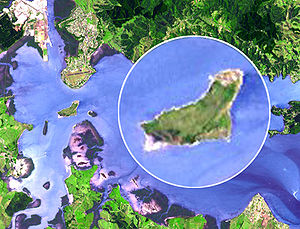Matakohe Island
|
Matakohe (Māori) Nickname: Limestone Island |
|
|---|---|

The island from above
|
|
| Geography | |
| Location | Whangarei Harbour, Pacific Ocean |
| Coordinates | 35°47′3″S 174°21′34″E / 35.78417°S 174.35944°E |
| Area | 0.37 km2 (0.14 sq mi) |
| Administration | |
|
New Zealand
|
|
| Northland |
|
| Demographics | |
| Population | 0 |
| Pop. density | 0 /km2 (0 /sq mi) |
Motu Matakohe, also known as Matakohe or Limestone Island, is a 37 ha (100 acre) island in the upper reaches of Whangarei Harbour, just off Onerahi, a seaside suburb of the city of Whangarei, Northland, New Zealand. Used for farming and industry for many years, the island is an example of ecological island restoration by a volunteer community group.
The earliest known inhabitants of the island were Ngaitahuhu Māori who occupied it in the early 18th century. They were dispossessed and driven out of the Whangarei area in the mid 18th century by Ngāpuhi Māori led by Te Ponaharakeke.
The first European house on the island was built in 1832, though later destroyed. In 1848 the island was leased from the Parawhau hapū by Robert Carruth and Mathew Whitelaw who established a limeworks there, using the local limestone. In 1865 the island was purchased by Henry Walton from Te Tirarau and the Parawahau chiefs. The limeworks were extended and sheep were farmed. In 1881 the first batch of Portland cement was produced, with the limeworks becoming a major local industry employing 270 people at its peak in the early 20th century. The island was later purchased by the Northland Harbour Board and used as pasture for several decades. In 1989 it was given to the Whangarei District, following which the first conservation and rehabilitation work began.
The island is managed by the Friends of Matakohe-Limestone Island Society (FOMLI), which was incorporated in 1991. In 1996 David Wright was employed as the Resident Ranger to look after and maintain the island. In 1999 it was gazetted as a scenic reserve, with a floating dock constructed for public access. Restoration work has involved massive plantings of native plants as well as the reintroduction and translocation of animals previously lost to the island and the surrounding region.
...
Wikipedia
